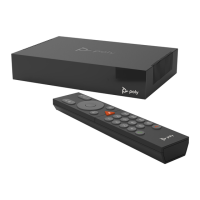Configuring Video Settings
Topics:
• High-Definition Video Conferencing
• Using Sleep Settings to Prevent Monitor Burn-In
• Configure Your USB Camera
• Use HDMI Input as the Camera Source
• Avoid Video Flicker
You can configure video settings for your G200 system.
High-Definition Video Conferencing
G200 systems can receive 1080p progressive format and display 1080p progressive or 1080i interlaced
format.
Near-site video displays in HD format when you use an HD video source and an HD monitor. However,
near-site video displays in SD if the system is in an SD or lower-resolution call.
The layout of a meeting varies with the number of participants. It accommodates nine people at most,
while the other participants stay outside the layout until they speak. A name card appears instead of the
video stream if the participant doesn’t turn on the camera.
Maximizing HDTV Video Display
When you use a television as your monitor, some HDTV settings might interfere with the video display or
quality of your calls.
To avoid this potential problem, update your HDTV settings using the following guidelines:
• Disable all audio enhancements in the HDTV menu, such as SurroundSound.
• Many HDTVs have a low-latency mode called Game Mode, which lowers video and audio latency.
Enabling this mode may improve your video conferencing experience.
• Before attaching your G200 system to a TV monitor, ensure the monitor is configured to display all
available pixels. This setting, sometimes known as fit to screen or dot by dot, enables the monitor to
display the entire HD image.
Note: The specific name of the monitor setting varies by manufacturer.
G200 System HDMI Interfaces
G200 systems include three HDMI interfaces: one for wired content sharing and two for monitor
connections.
The G200 system only supports HDMI to HDMI connections; the system doesn’t support conversions,
such as VGA to HDMI cable connections.
35

